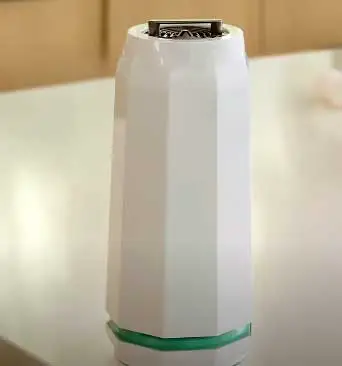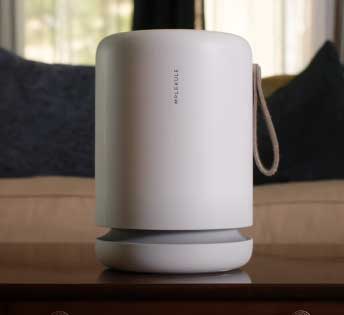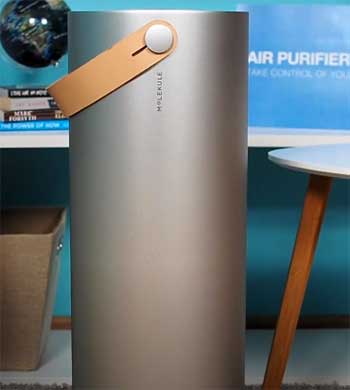Indoor air quality has become an increasing concern for many homeowners in recent years. From pet dander to wildfire smoke, there are a number of airborne pollutants that can accumulate inside your house.
Investing in an effective air purifier is one way to remove these pollutants and breathe healthier air indoors.
Two popular air purifier options are the Puraclenz and Molekule models. But how do you decide which one is right for your needs? This comprehensive guide examines the key differences between Puraclenz and Molekule to help you determine the best choice.
| Specs | Puraclenz | Molekule |
|---|---|---|
| Technology | Ionization + HEPA filter | PECO filtration + Pre-filter |
| Coverage | Up to 1600 sq ft | Up to 600 sq ft |
| Noise Level | 28 – 65 dB | 31 – 51 dB |
| Cost | $499 | $799 |
| Filters | Replace annually | Replace every 6 months |
| WiFi Capability | Yes | Yes |
| Alexa Compatibility | No | Yes |
| Warranty | 2 years | 2 years |
Puraclenz Technology Explained
The Puraclenz 3-stage air cleaning system consists of:

- Ionizer – Emits a plasma discharge creating millions of negatively charged ions that attach to floating positively charged particulates. This electrostatic charge causes airborne particles like dust, pollen, smoke, and pet dander to cluster together, growing heavier so they fall out of the airflow. This step alone significantly reduces concentrations of microscopic irritants.
- Pre-Filter – The next stage is a pre-filter made of a tightly woven mesh that traps larger particles including pet hair and lint, protecting the HEPA filter further downstream. This filter needs rinsing and replacing typically every 2-4 months depending on use.
- True HEPA Filter – Lastly, air passes through a true high efficiency particulate air (HEPA) filter. HEPA filters must remove a minimum 99.97% of particles measuring 0.3 microns (1/84th width of human hair) or greater. This includes allergens like mold, ragweed, and dust mite matter, bacteria, smoke, and other microscopic irritants that impact indoor air quality and health. Replacing annually provides peak performance.
Combining these purification stages allows Puraclenz models to eliminate an exceptionally broad spectrum of indoor air pollutants.
Units automatically sense VOC and particle levels using built-in air quality sensors, self-adjusting fan speeds as needed up to 4 settings from 28 decibels for very quiet night operation, ramping up to a max 65 decibels on the highest setting.
Their modern design has intuitive manual plus app-based controls and LED displays reporting current fan speed, mode settings, timer status, and filter replacement notifications. Advanced Puraclenz units include UV-C LEDs providing additional microbial control and continuous low level negatively charged ion emission between manual cleaning cycles to maintain cleaner air.
Covering over 1000 square feet, they purify the entire breathing space in even extra large rooms.
Molekule Technology Breakdown
Rather than filtration, Molekule air purification relies on advanced oxidation technology at the molecular level called Photo ElectroChemical Oxidation or PECO:

- Pre-Filter – Air first passes through a woven pre-filter catching larger particles like pet dander, pollen, dust and lint. It requires replacement every 6 months.
- PECO Reaction Chamber – The key technology, nano-coated surfaces in the PECO reaction chamber are activated by UV-A light waves. This process generates highly reactive hydroxyl radicals and oxidizing molecules. As these unstable compounds interact with airborne toxins like volatile organic compounds (VOCs), mold, bacteria, viruses and allergens, they breakdown pollutants into harmless trace elements at a molecular level that are orders of magnitude smaller than what HEPA filters can capture. Destruction also prevents live microbes like bacteria and viruses from reproducing downstream.
- Particulate Sensor + Auto-Adjust Fan – Laser particle sensors monitor incoming particulate concentrations automatically ramping the fan from near silent background airflow up to max settings around 50 decibels when pollutants spike. This dynamic auto-adjust purge keeps indoor air quality constant.
The touchscreen LED panel reports current particulate levels (high/medium/low based on particle counts) plus filter status and allows manually boosting fan speeds as desired.
All controls are also accessible via the Molekule app providing detailed charts and graphs tracking historical VOC and particulate levels. Integrating with Alexa and Google Home Assistant enables intuitive handsfree voice control of your Molekule air purifier as part of a smart home ecosystem.
With whisper quiet operation down to 31 decibels on auto-mode for small rooms, sound increases moderately at higher fan speeds necessary for adequate airflow through the PECO filter to effectively clean spaces up to about 600 square feet.
Now that you understand what’s under the hood, let’s compare their strengths and limitations.
Pros and Cons: Puraclenz Air Purifiers
Pros
- Uses medical-grade H13 HEPA filtration removing 99.97% of particles down to 0.3 microns, superior to cheaper models
- 3-stage system including ionization also reduces VOCs and light gases
- Modern app connectivity and intuitive controls
- Very energy efficient operation as low as 28 dB, ideal for bedroom use
- Can effectively clean extra large spaces up to 1600+ square feet
- Lower purchase price only around $500
Cons
- Ionizer component produces trace amounts of ozone emissions – negligible for most but could irritate those with severe lung issues
- Doesn’t destroy pollutants at molecular level like Molekule
- Replacing HEPA filters annually raises long term operating costs
- No integration for smart assistants like Alexa
Pros and Cons: Molekule Air Purifiers
Pros

- PECO nano-tech destroys VOCs, mold, bacteria and viruses at molecular level rather than just trapping particles
- Continuously monitors air quality providing detailed feedback
- Alexa and Google Assistant voice control builds into smart homes
- Widely praised by tech media outlets like Wired, New York Times, and more
- 5-year warranty demonstrates confidence in proprietary technology
Cons
- Far more expensive equipment and filter replacement costs
- Proprietary filters only available directly from Molekule
- Lower airflow can’t keep up in very large rooms exceeding 600 sq ft
- Some consumer review sites document failures just past warranty period
Carefully considering these trade-offs allows matching each model to your particular needs and room specs. Next let’s compare Puraclenz and Molekule head-to-head across buying factors.
Side-By-Side Comparisons
Cleaning Effectiveness
- Both Puraclenz and Molekule eliminate the vast majority of indoor air contaminants making rooms noticeably more breathable.
- For removing VOCs plus destroying mold, bacteria and airborne viruses down to non-reproductive trace elements, Molekule’s PECO technology provides superior performance.
- But when it comes to raw particulate filtration across very large spaces exceeding 1000 sq ft, Puraclenz air purifiers have greater airflow capacity for homes with big open floor plans.
Cost Considerations
- The initial purchase price only around $500 makes Puraclenz far more budget friendly compared to Molekule models starting around $800. This holds true when adding in ongoing filter replacement costs as well.
- Molekule filters cost over $120 every 6 months adding up vs cheaper and less frequent Puraclenz HEPA filter changes.
- However, consumers willing to invest upfront in Molekule’s innovative PECO tech often find the long term ownership experience validating the premium pricing via near-instant air quality improvements sensed.
Appearance + Controls
- Both air purifiers boast modern, compact designs blending seamlessly into living spaces.
- The Puraclenz offers intuitive manual touch controls while Molekule requires interfacing with a vivid touchscreen display enabling more settings adjustability including manual fan speeds and scheduling.
- Connecting to WiFi smart phone apps, you can remotely monitor air quality metrics, unit status, create operation schedules, and receive filter change notifications for both models as part of home automation ecosystems.
Noise Profile
- One advantage Puraclenz holds is a lower minimum decibel rating of 28 dBA making it the quieter option at night or for small rooms on low fan speed settings.
- However, Molekule Air Purifiers peak at just 51 dBA even on the highest smart-boost airflow needed to clean larger rooms efficiently.
- So noise levels remain relatively quiet for both, but favor Puraclenz for whisper-silent very large room coverage, and Molekule operating in smaller spaces.
Room Size Suitability + Coverage Capacity
- Here’s where the biggest divergence emerges. Molekule airflow and PECO filter cubic feet per minute (CFM) ratings top out at around 600 square feet of area. Stepping up to their highest output pro model improves coverage moderately but still comes up short for very large open concept spaces.
- In contrast, Puraclenz maximum 1600+ square footage purification capacity excel at keeping up with air exchange rates required in bigger rooms a Molekule model would struggle to impact.
Clearly identifying your room sizes and layout is necessary for determining the best match. Do you need to clean the air in a giant living room-kitchen combo that’s completely open? Or a contained master suite capped around 500 sq ft? Answering this questions clarifies which device fits.
Buying Considerations Summary
Here are key buying factors to help choose the right model for your needs and home specs:

- What is your budget? Molekule units cost considerably more upfront and ongoing. But Puraclenz becomes pricier long term factoring in consumables.
- What specific air pollutants most concern you – VOCs, smoke, pet dander, mold, or large particle allergies? PECO tech gives Molekule edge addressing gases and microbials.
- Do you have very large, open concept spaces exceeding 1000 square feet like a kitchen-dining-living combo? If yes, Puraclenz is the only viable option here.
- Noise sensitivity to very low 28 dBA levels? Only Puraclenz operates that quietly while still cleaning big rooms.
- Is integrating voice assistant control into a smart home important? Molekule works with Alexa and Google Home.
- Modern design aesthetics a factor? Both models are compact with attractive looks.
There’s no universally “best” or “worst” air purifying model. But using these key considerations as a decision making framework simplifies selecting what fits your indoor environment and lifestyle.
Next let’s go over some frequently asked questions about Puraclenz and Molekule from new buyers. Understanding these details often solidifies people’s choice.
Frequently Asked Questions (FAQ)
Yes, the first stage of Puraclenz air purification is an ionizer. It charges airborne particles using plasma so they bind together and fall out of circulation more easily. But it differs from standalone ionizers by also filtering particles.
Puraclenz uses a branded three stage cleaning process called IonicFusion that consists of ionization to group particles for better mechanical filtration, theirFusion pre-filter, and finally hospital-grade true HEPA filtration.
A small amount of ozone is created by the ionization component. However, Puraclenz models comply with CARB safety standards limiting ozone to negligible .01 parts per million similar to ambient outdoor levels. Their HEPA filter also mitigates risks. But those with severe lung issues should verify tolerability.
The parent company manufacturing Puraclenz products is BlessPure based in Walnut, California. They design advanced filters and purifiers used widely across medical, commercial, and residential applications.
PECO has been validated by numerous accredited labs and trails showing genuine destruction of common VOCs like formaldehyde at the molecular level unlike traditional filters. However, consumables and repairs make ownership very expensive over time.
PECO means Photo ElectroChemical Oxidation. The underlying science involves UV light activating nano-coated filters to produce hydroxyl radicals that oxidize pollutants on a chemical level in a catalytic reaction chamber.
Founded by research scientists and engineers at the University of Minnesota, the Molekule company continues leadership in clean air technology. Despite premium pricing of both equipment and consumables, they deliver an exceptionally effective cleaning solution.
For consumers seeking maximum VOC and microbial pollutant reduction without compromise, Molekule air purification systems often justify the substantial expense that comes with their unprecedented performance. It’s absolutely overkill for just eliminating pet dander and dust though where more affordable options get the job done.
Inside the PECO-Filter cartridges is a proprietary nano-porous synthetic medium designed to optimize the photochemical oxidation reactions. They tout it as 1,000 times thinner than a human hair.
Unfortunately no – Attempting to wash and reuse Molekule’s PECO filters designed for single-use will severely inhibit performance. Only brand new, unopened replacement filters sold directly by the company will provide genuine Molekule air purification.
Molekule recommends replacing filters every six months under normal usage. Their app monitors runtime hours and notifies when servicing is due. For households with significant indoor air quality issues from VOCs, smoke or heavy pet dander, more frequent three month service intervals may be necessary.
Closing Remarks
Still need any additional information or have more specific questions?
Let us know by replying here. Now that you understand both models inside and out including pros vs cons, operating costs, cleaning methods, effectiveness for room sizes, and other comparisons, deciding on Puraclenz or Molekule becomes much clearer.
We’re happy to provide any other details that helps you select the perfect air purifying system meeting your household needs and budget!
